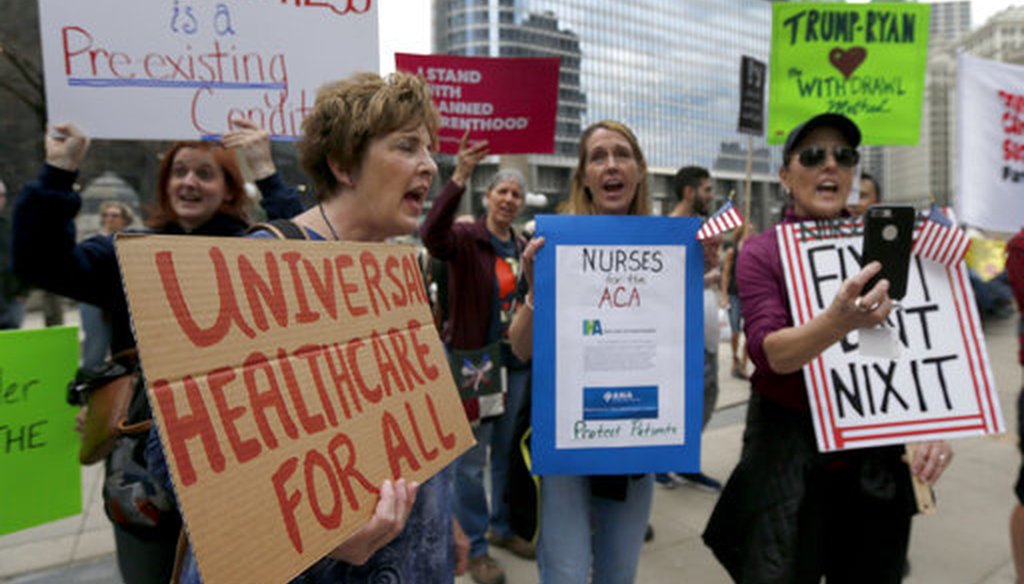Get PolitiFact in your inbox.

Protesters gather across the Chicago River from Trump Tower to rally against the repeal of the Affordable Care Act on March 24, 2017. (AP)
New numbers from the U.S. Census Bureau show an uptick in Americans who are uninsured but modest progress on poverty and income — handing Democrats and Republicans data for talking points.
Overall, the percentage of Americans lacking health coverage at any point in the year rose from 7.9% in 2017 to 8.5% in 2018. That’s according to annual numbers released Sept. 10.
The rise in the uninsured spanned demographic groups. Uninsured rates rose between 2017 and 2018 for whites, African Americans, Hispanic Americans, Asian Americans, native-born Americans, foreign-born Americans, people with disabilities, people without high school degrees, and those under 18.
The 2017 and 2018 figures are not directly comparable with previous years due to changes in how the data is calculated. But a different data set showed that the small rises in the uninsured rate for 2017 and 2018 marked a change for a number that had improved every year since its peak in 2010, when the Affordable Care Act was passed. The law created a national marketplace for individual insurance and allowed states to expand Medicaid to more people.
Democrats pounced on the data release, with House Speaker Nancy Pelosi, D-Calif., blaming "President Trump’s cruel health care sabotage," including his efforts to pare back the Affordable Care Act through regulations and in court.
But the Trump administration could point to modest gains in other statistics reported by the Census Bureau.
"Americans of all backgrounds are experiencing economic success in the Trump economy," the White House said in a statement that cited media coverage of the new numbers on income and poverty.
The U.S. poverty rate fell for the fourth consecutive year, from 12.3% in 2017 to 11.8% in 2018. The national poverty rate is currently lower than it has been in any year since 2000, as this chart indicates.
Meanwhile, median household income rose for the fourth consecutive year after adjusting for inflation. It was a small rise, however, from $62,626 in 2017 to $63,179 in 2018, or an increase of less than 1%. And the pace of growth has slowed somewhat since the middle of this decade.
A leading measure of income inequality known as the GINI coefficient dipped slightly between 2017 and 2018. But its decades-long rise toward greater inequality was not greatly slowed.
Under this measurement, a score of 0.0 represents total income equality, while a score of 1.0 represents total inequality.
The overall statistics for poverty and income also mask significant differences by race and ethnicity.
In 2018, for instance, the poverty rate for whites was 8.1%. But it was much higher for African Americans (20.8%) and Hispanic Americans (17.6%) and modestly higher for Asian Americans (10.1%).
The poverty rate fell slightly in 2018 for whites, African Americans and Hispanic Americans, while rising slightly for Asian Americans.
Our Sources
U.S. Census Bureau, "Income, Poverty and Health Insurance Coverage in the United States: 2018," Sept. 10, 2019
U.S. Census Bureau, "Health Insurance Coverage in the United States: 2018" (full report), Sept. 2019
U.S. Census Bureau, "Health Insurance Coverage in the United States: 2018" (index page), Sept. 10, 2019
U.S. Census Bureau, "Historical Poverty Tables: People and Families - 1959 to 2018," accessed Sept. 10, 2019
Nancy Pelosi, "Pelosi Statement on Census Report Finding 2 Million More Uninsured Under President Trump," Sept. 10, 2019
Bob Casey, tweet, Sept. 10, 2019






































